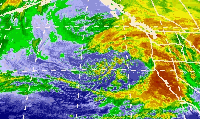This article needs to be updated.(December 2015) |
 Melor prior to peak intensity on October 4 | |
| Meteorological history | |
|---|---|
| Formed | September 29,2009 |
| Extratropical | October 8,2009 |
| Dissipated | October 11,2009 |
| Violent typhoon | |
| 10-minute sustained (JMA) | |
| Highest winds | 205 km/h (125 mph) |
| Lowest pressure | 910 hPa (mbar);26.87 inHg |
| Category 5-equivalent super typhoon | |
| 1-minute sustained (SSHWS/JTWC) | |
| Highest winds | 280 km/h (175 mph) |
| Lowest pressure | 911 hPa (mbar);26.90 inHg |
| Overall effects | |
| Fatalities | 3 total |
| Damage | $1.5 billion (2009 USD) |
| Areas affected | Mariana Islands,Japan,Philippines,California |
| IBTrACS | |
Part of the 2009 Pacific typhoon season | |
Typhoon Melor,known in the Philippines as Super Typhoon Quedan,was a powerful typhoon that hit Japan in early October 2009,causing significant damage. As part of the 2009 Pacific typhoon season,Melor formed as a tropical depression on September 29 and rapidly intensified into a Category 4-equivalent typhoon just three days later. Subsequently,on October 4,Melor became the second Category 5-equivalent super typhoon to form in the season. During the next days,the typhoon would interact with Typhoon Parma southeast of Taiwan,causing Parma to be almost stationary over northern Luzon and drop near-records of rainfall there. Afterwards,Melor gradually weakened in its approach to Japan,making landfall on October 7. As the storm exited Japan during the next day,it transitioned into an extratropical cyclone. The remnants of Melor were absorbed by a newly-formed extratropical cyclone near Alaska,which strengthened significantly and impacted the West Coast of the United States on October 13.
Contents
- Meteorological history
- Preparations
- Japan
- Impact and aftermath
- Mariana Islands
- Japan 2
- California
- See also
- References
- External links
Following the typhoon,Melor caused 3 fatalities and $1.5 billion (2009 USD) in monetary damages in Japan.




